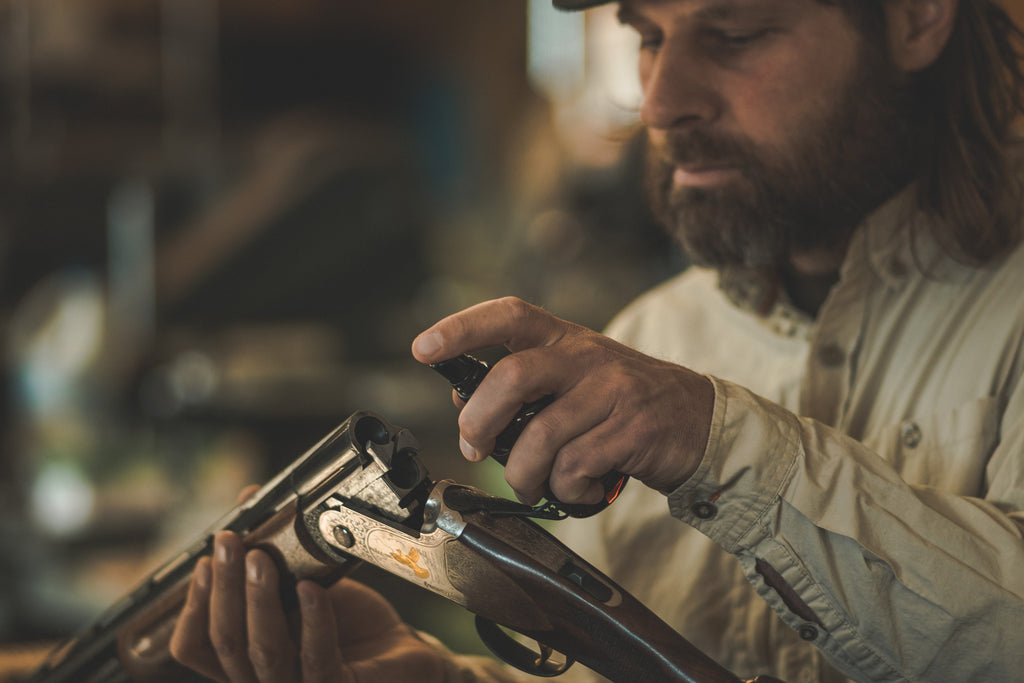Properly Lubricating Your Gun

Ask ten gun owners how they clean their firearms and you’ll probably get ten different answers. Some will be confident in their methods and others will admit it’s just the way they’ve always done it. The level of cleaning will vary each time you do it, depending on how dirty it is or what kind of weather it was exposed to.
Normal care of your firearms can be broken into to four sections:
- Stock or Grips
- Bore
- Metal Surfaces
- Optics(if applicable).
All of these parts of your firearm are very important to keep properly maintained so that your firearm continues to function as designed, with the utmost accuracy. We’re going to take a deep look at taking care of the metal surfaces, as they are most likely to cause issues such as rust. You should approach this process based on the type of metal and finish that is applied to your firearm. First, let’s talk about “gun oil” and why it differs from conventional oils.
“Gun Oil”
If you’ve ever walked into a sporting goods store, you are likely to encounter a multitude of oils and lubricants designed for firearms. They are usually pretty expensive compared to your oils in the auto parts section, but why? What’s the difference?
If you look past the fancy marketing, gun oils do have an advantage over conventional oils in that they are more refined and usually have additives that tailor their performance to firearms. Mountain tribes in the mountains of Afghanistan have kept their AKs running with motor oil for decades and it works, but that doesn’t mean it’s the best option available for your firearm. Motor oil works ok as a lubricant but really lacks the corrosion resistance.

I was brought up spraying WD-40 on everything, it made the gun feel smooth which in my mind translated to it was doing a good job. However, that feeling was only temporary and my firearms always ended up being extremely dirty even after the slightest use. There are applications for WD-40 in gun work but not for day-to-day use. WD-40 was designed as a water displacing agent not a protecting or lubricating oil. To put it shortly, keep the WD-40 off the bench when cleaning your firearms.
Gun oil should have a few key features. First, it should protect against corrosion. For steel parts and others susceptible to rust, it will coat and reduce the chances of rust. Secondly, it needs to lubricate. Lubrication is a lot more than making it feel smooth. It is about reducing wear and tear on parts. Operating smoothly is a byproduct of that. Lastly, it should be the right consistency for its intended use. For general rust protection, it needs to be thin enough that it will stay on the surface. Oil that runs and drips can cause a lot of long term issues that we’ll discuss later.
It is important to note that a single gun oil may not be ideal for all of your firearms. For example, the oil you use on your hunting rifle may differ from what you lubricate your AR with. Some oils do better when exposed to higher heats and vice versa. When in extreme cold environments, it may be beneficial to ditch the gun oil entirely and switch to graphite powder.
I personally prefer to use non-hazardous gun oils like Sage & Braker’s CLP (Clean, Lube, Protect). Being a full time gunsmith, I am exposed to them more than the average person and want to reduce the risks of any long term effects. While not necessary, it is worth considering.
Blued, Browned, or Parkerized Steel
Bluing is found on more firearms than not and by far the most popular metal finish on firearms today. It has been used for 100+ years and if properly cared for, remains a great option for firearms finishes. The bluing on steel is made to work in conjunction with oils to create a corrosion resistant surface. Therefore, to work properly it needs to have a light coating of oil on it. I like to apply oil heavily with a patch, never letting it get to the point of being so thick that it forms droplets that run. After a few minutes I wipe the excess off with a couple dry cleaning patches. I do this while it is removed from the stock as to not introduce oil to the stock. This leaves you with a light film of oil that will protect the surface from rust and lubricate where necessary.
Stainless Steel
While stainless steel is made with excellent corrosion resistance properties, it still can rust. Luckily, it doesn’t rust as fast or as badly as conventional blued steel. Care of stainless steel parts can be as simple as removing any carbon or foreign build up using CLP and a nylon brush. Then, apply a light coating of CLP to a cleaning patch or rag and wipe down the part. Doing this regularly will ensure your stainless steel is protected from corrosion.
Painted on Finishes
This covers Cerakote, Durakote, and Hydro Dipping. At this point, most firearms manufacturers have jumped on the “painted on” finish train, for a good reason. For example, Cerakote is a very durable finish that when properly done protects the steel like nothing else. With these types of coatings, it is not necessary to keep a light coating of oil on the exterior finish. Though, you should still keep your internal parts lightly lubricated. With many of these alternate finishes, the internal parts are left blued or in the white(without finish), so it may be necessary to oil them like your other firearms.
The Potential Dangers of Over Oiling
Have you ever been in a used gun shop and seen the old rifle that has the dried up or warped recoil pad? That is caused by over oiling. When you apply too much oil and leave it on the gun, it will tend to build up and run. If you keep your rifle in a gun safe or cabinet, it is more than likely sitting with the barrel toward the ceiling. Over time, the oil will run down the firearm and end up soaking into the rubber recoil pad.

Example of Parker shotgun's stock exposed to too much oil.
The same principle wreaks havoc on old double guns. In these types of firearms, the oil tends to settle on the breech face, and make its way inside the action. It then works its way back to the head of the stock and over time tends to rot the wood. This leads to cracking and chipping of the wood under recoil. Therefore, it is very important to not over oil your firearms as it may have long term effects. For firearms like AR-15s and synthetic stocked guns this may not be an issue.
In short, applying oil regularly when using a firearm is generally a good idea to prevent corrosion and reduce wear. This is common knowledge to most firearms owners, but I truly believe that most people tend to over oil in fear of it rusting when not in use. If properly oiled, your firearms will keep going for many years and can be handed down from generation to generation.
Written by Kurt Martonik
